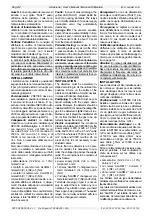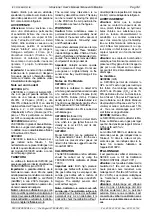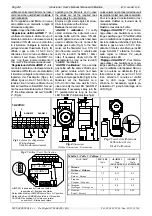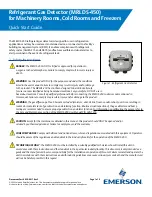
Pag.2/4
Istruzione / User’s Manual / Manuel d’utilisation
IST-2138.KM01.01/B
TECNOCONTROL S.r.l. Via Miglioli 97 SEGRATE ( MI ) Tel: 02/26 92 28 90 Fax: 02/21 33 734
Guasti:
In caso di guasto del sensore si
illumina il Led giallo “FAULT” posto
all’interno della custodia. I relè sono
normalmente eccitati, per cui se manca
l’alimentazione si diseccitano.
Periodo di funzionamento:
il Sensore
utilizzato ha una buona stabilità nel tem-
po. In condizioni di funzionamento nor-
male in aria pulita la vita del sensore è
circa 10 anni dalla data installazione.
Verifiche Periodiche
:
Si consiglia di
effettuare la verifica di funzionamento
ogni 6 mesi e ogni anno procedere alla
ritaratura del circuito con miscela
Gas/Aria come indicato a Pag. 3 e 4.
Nota importante:
tenere presente che
in ambienti particolarmente inquinati o
con vapori di sostanze infiammabili (in
particolare solventi), può essere neces-
sario effettuare più spesso la verifica e/o
la taratura periodica. Inoltre la vita utile
del sensore può ridursi notevolmente.
INSTALLAZIONE
I rivelatori vanno installati e posizionati
seguendo tutte le norme nazionali vigen-
ti per gli impianti elettrici nei luoghi con
pericolo di esplosione e le norme di sicu-
rezza degli impianti.
Posizionamento:
L'SE138K deve es-
sere installato in posizione verticale con
il sensore rivolto verso il basso. E` op-
portuno inoltre installare l'SE138K in alto
a 20-30cm dal soffitto se il gas da rileva-
re è più leggero dell'aria (es.metano), a
20-30cm dal pavimento se il gas da rile-
vare è più pesante dell'aria (es.GPL).
Collegamenti elettrici:
la distanza
massima cui può essere installato ogni
SE138K dall'alimentatore è di 800 m
con cavo da 1,5 mm
2
e di 1400 m con
cavo da 2,5 mm
2
a 12 Vcc, mentre è di
7500 m con cavo da 1,5 mmq e di
13000 m con cavo da 2,5 mm
2
a 24
Vcc. Non è necessario utilizzare cavi
schermati.
Nel caso di alimentazione di più appa-
recchi in parallelo, è necessario tener
conto della caduta di tensione sui tratti
comuni dei cavi. I collegamenti da effet-
tuare sono:
•
alimentazione (12-24Vcc +/- 10%):
morsetti 1 e 2;
•
contatti in scambio relè ALARM 1:
morsetti 3 (C), 4 (NC) e 5 (NA);
•
contatti in scambio relè ALARM 2::
morsetti 6 (C), 7 (NC) e 8 (NA).
I morsetti sono del tipo ad innesto: è ne-
cessario sfilarli per effettuare i collega-
menti. Prestare attenzione nel reinserirli
dato che sono polarizzati.
I relè, di tipo sigillato, sono normalmente
eccitati con contatti in scambio liberi da
tensione. Il relè “ALARM 2” è ritardato di
circa 40 secondi.
Faults
:
In case of sensor damage, the
yellow LED (FAULT), placed inside the
cast iron housing, illuminate The relays
are normally activated: if a power supply
interruption occur, they automatically
deactivate.
Average life:
The sensor’s sensitive
element has an exellent stability in time.
In pure air and in normal working condi-
tion the sensor's life is about 10 years
from the date of installation.
Periodical testing:
we advise to carry
out working tests every six months. After
1 year we advise to proceed to the re-
calibration of the circuit with Gas/Air mix-
ture as explained on page 3 and 4.
Attention:
please note that in polluted en-
vironments, where vapours of flammable
agents, especially solvents, might be pre-
sent, the periodical testings and recalibra-
tions should be carried out at shorter time
intervals. In polluted environments the sen-
sor's life can be reduced.
INSTALLATION
The detectors must be accurately in-
stalled according to all the national dis-
positions in force on the safety of the
plants and installation of electric devices
in areas with danger of explosion.
Positioning:
The SE138K must be posi-
tioned vertically with the sensor down-
wards. Moreover, the detector should be
installed at 20-30 cm below the ceiling if the
gas to be detected is lighter than air (ex.,
Methane), but it should be installed at 20-
30 cm from the floor if the gas to be de-
tected is heavier than air (ex., LPG).
Electric connections:
the maximum
distance to install each SE138K from the
power supply is 800 m with a 1,5 mm
2
cable and 1400 m with a 2,5 mm
2
cable
at 12 Vdc, whereas is 7500 m with a 1,5
mm
2
cable and 13000 m with a 2,5 ca-
ble at 24 Vdc. It is not necessary to use
shielded cables.
If more than one detector is to be pow-
ered in parallel, it is necessary to con-
sider the voltage drop across the supply
cable. The connections to be carried out
are as follows:
•
power supply (12-24 Vdc +/- 10%):
terminals 1 and 2
•
1st relay “ALARM 1” changeover con-
tacts: terminals 3 (C), 4 (NC) and 5
(NO).
•
2nd relay “ALARM 2” changeover con-
tacts: terminals 6 (C), 7 (NC) and 8 (NO).
Terminals are plug-in type: it is neces-
sary to extract them to make any con-
nections. Pay attention when you insert
them again, being polarized. The sealed
relays are normally activated with ten-
sion free changeover contacts.
Dérangement:
en cas de déterioration
du capteur, la LED jaune (FAULT), pla-
cé dans le boîtier, s’illumine. Quand il se
vérifie une coupure d’alimentation le re-
lais se déclenche.
Vie moyenne:
Le capteur a une excel-
lente stabilité dans le temps. En condi-
tion de fonctionnement normale en air
non pollué, la vie utile du capteur est
d'environ 10 ans à partir de la date de
mise sous tension.
Verification périodique:
Il est conseillé
d'effectuer une vérification de fonction-
nement après 6 mois, et pendant
l’année de procéder au réétalonnage du
circuit avec un mélange gaz/air, réperto-
rié en page 3, 4.
Attention:
En milieu particulièrement pol-
lué, avec présence de vapeurs inflamma-
bles et de solvants, il peut être nécessaire
d'augmenter la fréquence des temps de
vérification et d'étalonnage. En outre la vie
du capteur peut être réduite.
INSTALLATION
Les sondes doivent être installées selon
les normes en vigueur pour les installa-
tions électriques dans les locaux avec
danger d'explosion et les normes de sé-
curité des installations.
Positionnement:
le SE138K doit être
installé en position verticale et le capteur
doit être tourné vers le bas. Le détecteur
doit être installé à une hauteur de 20-30
cm du plafond si le gaz à détecter est
plus léger que l’air (ex. Méthane) et à 20-
30 cm du plancher si le gaz à détecter
est plus lourd que l’air (ex. GPL).
Raccordements électriques:
La dis-
tance maximale à laquelle peut être rac-
cordé le SE138K avec alimentation en
12Vcc est de 800 m avec câble 1,5mm
2
et 1400 m avec câble 2,5mm
2
. Avec
alimentation en 24Vcc est de 7500 m
avec câble 1,5mm
2
et 13000 m avec
cable 2,5mm
2
.
Si l’on a l’alimentation de plusieurs appa-
reils en parallèle, il faut considérer la
chute de tension sur les câbles. Les
connexions sont:
•
alimentation (12-24 Vcc +/- 10%):
borniers 1 et 2.
•
1er relais “ALARM 1” borniers 3
(F), 4 (NF) e 5 (NO);
•
2éme relais “ALARM 2” borniers 6
(F), 7 (NF) e 8 (NO);
Les borniers sont de type débrochables
polarisés et pour effectuer les connexions il
faut les débrocher.
Les relais sont normalement excités avec
contact inverseurs libres de tension. Le re-
lais “ALARM 2” est retardé d’environ 40
secondes. Ce retard peut être éliminé, en
modifiant la position du cavalier sur le






















